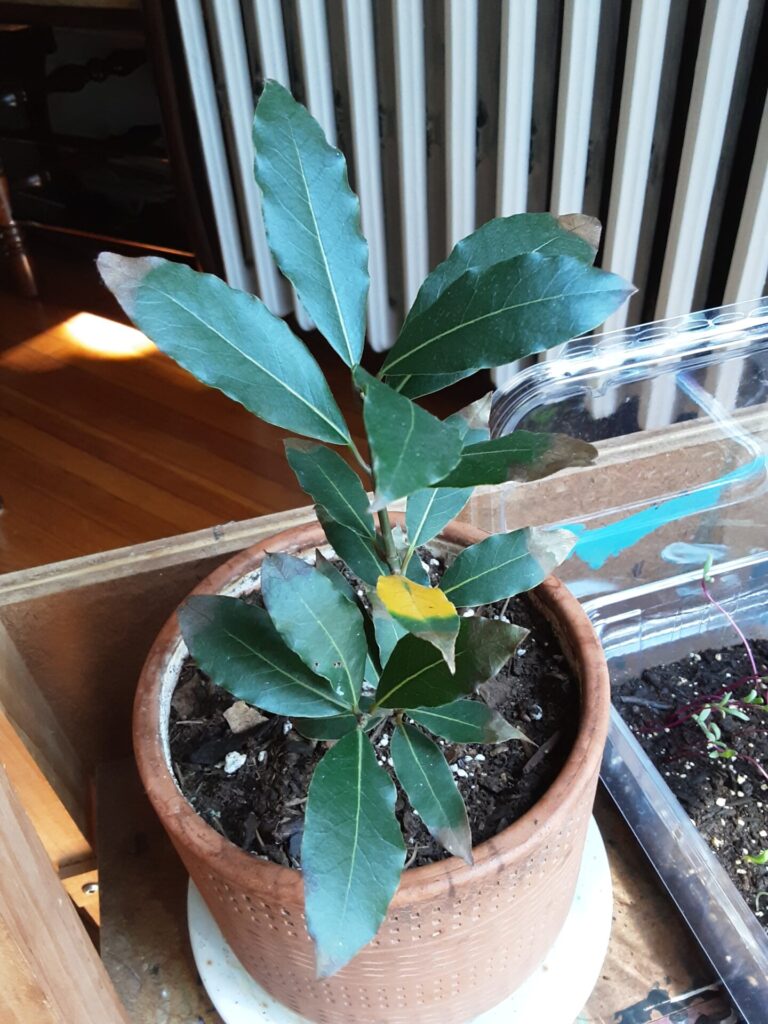
I have a bay laurel which I bought last year as a small plant with just a few leaves. It had a large and lively root structure, and grew vigorously outside in a clay pot through last summer. I brought it inside in the fall, and have it by a window – south-facing, but shaded from direct sun by surrounding buildings through a lot of the day. It was happy enough until about mid-February, when it started showing some brown leaf tips.
I’ve tried to be careful not to over-water, and do occasionally test the soil with a moisture meter. Perhaps I’ve let it dry out too much, too often? Or perhaps the pot doesn’t breathe as well as it might, and some root rot has set in?
I’ll be inspecting the roots and renewing the soil, and hoping that outside light will help it pick up again once it’s warm enough to put it outside again.
I’ve grown Bay before, and know about the propensity for scale – this plant doesn’t yet have any of that.
Attached is a photo… are you able to tell me what is my likely issue, if there’s anything I can do immediately and if there are specific things to address when I’m transitioning to its outdoor season?
Many thanks in advance… cheers!
First, you should know that you are not alone! I’ve (again) had a similar issue with my 2 small bay laurels. I think they’ve simply had it with winter! Mine have some brown-edged leaves like yours and (as an added bonus) a few stems have become crispy (dead) at the ends – but otherwise they seem fine and new growth is emerging. This happens to me every winter season, and in the past, I have kept my plants indoors all year. This year, I’m considering repotting them and putting them outdoors so they can better thrive. I think I’ll follow your lead!
Issues for to consider as the cause of the browning tips are:
- Sun: The plant enjoys a sunny spot – try moving it to a place where it gets some more direct sun.
- Soil: Does the potting soil drain well? If not, repot now, as the roots could be getting soggy, don’t wait until you move it outdoors.
- Check to see if the surface soil has compacted – this could prevent water from reaching the plant roots efficiently.
- Water: Keep the soil evenly moist, don’t overwater as the plant does not like wet feet. Nor should the soil be allowed to dry out completely.
- The clay pot should let the plant roots breathe, and excess water to evaporate, so I don’t think that’s the issue.
- In my case, I feel that I’ve let the plants get too dry, several times over the winter — I believe this is why my plants’ leaf tips have browned (and why a few stem tips are crispy). This may be what happened with your plant too.
- I’ve started watering several of my houseplants from the bottom – as opposed to pouring water onto the top surface of the soil. This way, the potting soil can absorb water slowly, through the pot’s drainage holes. This encourages deeper roots, as they stretch down to absorb water. In some cases, soil can get so dry it pulls away from the side of the container and watering from the top can result in the water simply pouring down the sides of the container, not (as it should) through the potting soil. Bottom-watering gives soil the opportunity to soak up water and rehydrate. Caution though as if the soil has compacted, it may not be able to absorb water properly. See Horticulture Magazine’s A guide to bottom watering for potted plants. This article also includes some terrific links.
- Fertilizer: During the growing season from late spring to summer, fertilize every 2 weeks. It’s now the end of March and I started using liquid fertilizer (at half the recommended dose) every second watering, starting around March 1st. You might want to start fertilizing your plant – I see that you also have a yellowed leaf, which could be a sign of nutritional deficiency (although wet roots can cause yellowing too).
For more information, see How to Grow Bay: a Toronto Master Gardeners Guide. This article includes several helpful links, especially those of the UK’s Royal Horticultural Society (Bay trees) and U Illinois Extension.
All the best with your bay laurel, I’m sure it will thrive come summer!

